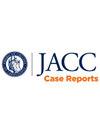Concomitant Transcatheter Aortic and Mitral Valve Replacement
Q4 Medicine
引用次数: 0
Abstract
Background
Multivalvular heart disease is a highly prevalent condition that causes significant morbidity and mortality.
Case Summary
A 75-year-old man presented with worsening functional class and asthenia. A transthoracic echocardiogram showed severe aortic stenosis and severe mitral stenosis. The patient underwent transcatheter aortic and mitral valve replacement in the same procedure.
Discussion
There is a lack of solid evidence regarding the management of multivalvular disease. Severe mitral stenosis can influence aortic stenosis, potentially leading to a low-flow, low-gradient profile. Establishing a streamlined workflow between transesophageal echo and cardiac tomography optimizes procedural safety, efficiency, and outcomes in patients with concomitant mitral and aortic disease.
Take-Home Messages
This case highlights the relevance of multimodality imaging for procedural planning in complex multivalvular disease. Concomitant transcatheter implantation of transcatheter aortic valve replacement for aortic stenosis followed by a transcatheter mitral valve replacement in mitral stenosis is a feasible option for patients at high surgical risk.
合并经导管主动脉瓣和二尖瓣置换术。
背景:多瓣心脏病是一种非常普遍的疾病,发病率和死亡率都很高。病例总结:一名75岁男性,表现为功能等级恶化和虚弱。经胸超声心动图显示严重主动脉瓣狭窄和二尖瓣狭窄。患者在同一手术中接受了经导管主动脉瓣和二尖瓣置换术。讨论:关于多瓣膜疾病的治疗缺乏可靠的证据。严重的二尖瓣狭窄会影响主动脉瓣狭窄,可能导致低血流、低梯度。在经食管超声和心脏断层扫描之间建立简化的工作流程,可优化合并二尖瓣和主动脉疾病患者的手术安全性、效率和预后。关键信息:本病例强调了多模态成像与复杂多瓣膜疾病手术计划的相关性。主动脉瓣狭窄患者同时行经导管主动脉瓣置换术,二尖瓣狭窄患者同时行经导管二尖瓣置换术,对于手术风险高的患者是一种可行的选择。
本文章由计算机程序翻译,如有差异,请以英文原文为准。
求助全文
约1分钟内获得全文
求助全文
来源期刊

JACC. Case reports
Medicine-Cardiology and Cardiovascular Medicine
CiteScore
1.30
自引率
0.00%
发文量
404
审稿时长
17 weeks
 求助内容:
求助内容: 应助结果提醒方式:
应助结果提醒方式:


